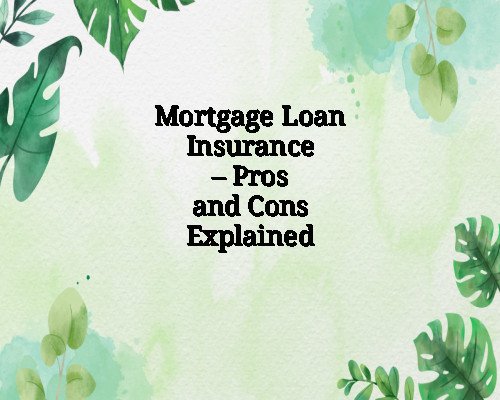Mortgage Loan Insurance – Pros and Cons Explained
Mortgage loan insurance protects lenders in case a borrower defaults on their home loan, but it also has key implications for borrowers to consider.
What is Mortgage Loan Insurance?
Mortgage loan insurance (also known as private mortgage insurance or PMI in some countries) is a policy that protects the lender if a borrower fails to repay their home loan. It is typically required when the borrower’s down payment is less than 20% of the home’s purchase price. This type of insurance is common in countries like the United States and Canada and is especially relevant in high-ratio mortgage scenarios.
While it adds to the overall cost of homeownership, mortgage loan insurance opens the door to buying a home sooner than one might otherwise afford. However, this financial tool comes with both advantages and disadvantages that every borrower should weigh carefully.
How Mortgage Loan Insurance Works
When a borrower makes a down payment of less than 20%, the lender faces a higher risk. To mitigate this risk, lenders require the borrower to purchase mortgage loan insurance. The premiums can be paid as a lump sum, added to the loan amount, or paid monthly. If the borrower defaults, the insurer reimburses the lender for the outstanding mortgage balance.
In some cases, the insurance is provided by a government-backed entity like the Canada Mortgage and Housing Corporation (CMHC), or by private insurers in the U.S. such as MGIC or Genworth.
Pros of Mortgage Loan Insurance
Enables Low Down Payments
The most significant advantage is that it allows buyers to secure a mortgage with as little as 3%–5% down. Without this insurance, many first-time homebuyers would have to wait years to save up a 20% down payment, especially in high-cost housing markets.
Access to Better Interest Rates
Since the insurance reduces the lender’s risk, borrowers with mortgage loan insurance often qualify for better interest rates compared to uninsured high-ratio mortgages. Over the life of the loan, even a small difference in interest rates can save thousands.
Encourages Responsible Lending Practices
Mortgage insurance companies often require borrowers to meet strict eligibility criteria. These include verifying income, employment, and creditworthiness. This ensures borrowers are financially capable of managing their mortgage obligations, reducing default rates across the industry.
Boosts Homeownership Rates
By enabling more people to buy homes with lower upfront capital, mortgage loan insurance contributes to broader homeownership rates. This in turn can strengthen communities and contribute to economic growth.
Peace of Mind for Lenders
Lenders gain security knowing they will be compensated in case of borrower default. This encourages them to offer loans to a broader pool of applicants, increasing competition in the mortgage market, which can benefit borrowers.
Cons of Mortgage Loan Insurance
Adds to Monthly Costs
Mortgage loan insurance isn’t free. It adds a recurring or upfront cost to homeownership, depending on how the premiums are structured. These costs do not go toward the loan balance and are non-refundable, making them an added financial burden.
Doesn’t Protect the Borrower
A common misconception is that mortgage loan insurance protects the homeowner. In reality, it protects the lender. If you default and the home is foreclosed, the insurer compensates the lender—not you. You may still face a foreclosure and damage to your credit score.
Limited to High-Ratio Mortgages
Mortgage loan insurance is generally only required for borrowers who put down less than 20%. This means buyers who can afford a larger down payment often choose to avoid the extra cost, even if it means waiting longer to buy.
Can Be Difficult to Cancel
In some countries, canceling mortgage insurance isn’t automatic once you reach 20% equity. You may need to request it formally, meet certain criteria, and pay for a new appraisal to prove the home’s value. If home values drop, it may take even longer to reach the equity threshold required to eliminate insurance.
Total Loan Cost Increases
Even if the insurance allows you to buy sooner, the overall cost of your loan increases. With higher monthly payments due to insurance premiums, and the potential for a longer payoff period, you may end up paying more over time.
Cost Structure of Mortgage Loan Insurance
The cost of mortgage loan insurance depends on the size of the loan, the amount of the down payment, and the type of mortgage. Premiums typically range from 0.5% to 4% of the loan amount. Here’s a general example:
-
5% down payment: Premium may be around 4.0% of the loan
-
10% down payment: Premium drops to around 2.4%
-
15% down payment: Premium could be as low as 1.8%
These premiums may be rolled into the mortgage or paid upfront at closing. Rolling them into the mortgage means you’ll also pay interest on the premiums, increasing your overall loan cost.
When Is Mortgage Loan Insurance Worth It?
You’re a First-Time Buyer
If you’re a first-time homebuyer without the savings for a 20% down payment, mortgage insurance can be your ticket to homeownership. The trade-off between added cost and getting into a home sooner may be worthwhile if prices are rising or if renting is equally expensive.
You Expect Your Income to Grow
If you expect your income to rise in the near future, you may be more comfortable taking on the added insurance cost now, knowing you’ll refinance or cancel the insurance once your equity improves.
The Real Estate Market Is Hot
In a fast-appreciating market, delaying a purchase to save up a larger down payment might mean paying more for a home later. Getting in sooner with mortgage insurance might be financially smarter than waiting.
When to Avoid Mortgage Loan Insurance
You Can Afford to Wait and Save
If your financial situation allows you to wait and save for a larger down payment, avoiding the cost of mortgage insurance may be preferable. This will also reduce your loan size and interest payments over time.
You’re Buying in a Declining Market
If home values are expected to drop, your equity could erode, delaying the point at which you can cancel the insurance. In such cases, it’s better to secure a mortgage with a larger down payment to avoid PMI and protect your equity.
You Plan to Stay Short-Term
If you’re planning to sell within a few years, paying for insurance you’ll never get back might not be worth it. Even if you cancel it early, the upfront costs may outweigh the benefits unless your home appreciates rapidly.
Alternatives to Mortgage Loan Insurance
Piggyback Loans
In the U.S., a common alternative is a piggyback loan—taking out a second mortgage to cover part of the down payment, allowing you to avoid PMI. However, the second mortgage often carries a higher interest rate, so you need to do the math.
Lender-Paid Mortgage Insurance (LPMI)
Some lenders offer to cover the insurance themselves but charge you a higher interest rate instead. This option avoids the visible monthly insurance payment, but may end up costing more over the life of the loan.
Government-Backed Loans
FHA loans in the U.S. and CMHC-backed loans in Canada have their own insurance systems with different cost structures. Some borrowers find these more affordable depending on their credit profile and income level.
Tips for Managing Mortgage Loan Insurance
-
Shop Around: Lenders may offer different insurance providers or terms. Compare options.
-
Refinance Early: As soon as your equity hits 20%–22%, explore refinancing or requesting insurance cancellation.
-
Boost Home Value: Renovations or appreciation may push your equity above the threshold sooner, allowing early removal of insurance.
-
Understand Your Rights: Know when and how insurance can be canceled in your country or region.
Final Thoughts
Mortgage loan insurance can be a powerful tool for getting into a home sooner with a smaller down payment. For many first-time buyers, it makes the dream of homeownership a reality. However, the added costs and limitations mean it’s not the best choice for everyone. Evaluate your financial situation, future plans, and the real estate market before committing. A well-informed decision can save you money and bring you closer to your long-term financial goals.

